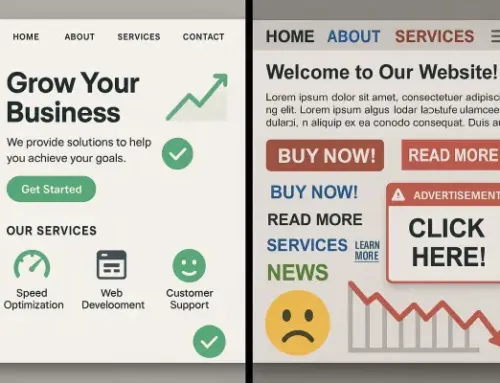Have Questions? Let’s Talk!
Did you know that 53% of mobile users will leave a site if it takes more than three seconds to load? Speed and smooth performance aren’t just “nice to have”, they’re make-or-break factors for both your Google rankings and your customer experience.
That’s where Core Web Vitals come in. These three performance metrics, Largest Contentful Paint (LCP), First Input Delay (FID), and Cumulative Layout Shift (CLS), are part of Google’s ranking algorithm. They measure how quickly your site loads, how responsive it feels, and how stable it appears while loading. In short, they reflect how real users experience your site.
For hospitality, retail, and service-based businesses, the stakes are high. A slow-loading menu page, a booking form that lags, or a layout that shifts unexpectedly can frustrate customers before they’ve even had the chance to engage with your business. And when Google notices poor performance, your search visibility can take a hit.
At SORA Partners, we specialize in optimizing websites so they’re not just visually appealing, they’re fast, stable, and user-friendly, helping you rank higher and convert more visitors into loyal customers.
What Are Core Web Vitals?
Core Web Vitals are a set of three key metrics created by Google to measure how real users experience your website. Instead of focusing only on technical SEO factors like keywords or backlinks, these metrics zero in on how quickly and smoothly your site loads, responds, and stays visually stable.
Here’s what each one measures:
1. Largest Contentful Paint (LCP) – Loading Speed
2. First Input Delay (FID) – Interactivity
3. Cumulative Layout Shift (CLS) – Visual Stability
These aren’t just abstract performance scores, they directly influence your search rankings. When your site meets or exceeds Google’s Core Web Vitals thresholds, you’re signaling that you provide a fast, frustration-free experience, which both search engines and customers value.
Why Core Web Vitals Matter for SEO
Google’s mission is simple: deliver the most relevant, high-quality results for every search. That means your site’s user experience is just as important as the content it delivers. Core Web Vitals are Google’s way of measuring that experience, directly influencing where your website appears in search results.
Here’s why they matter for your SEO:
1. Direct Ranking Factor
Since 2021, Core Web Vitals have been part of Google’s Page Experience Update. If your site scores poorly in these metrics, it can rank lower, even if your content is strong, because Google prioritizes fast, user-friendly websites.
2. Mobile-First Indexing
Most searches now happen on mobile devices, and Google ranks sites based on their mobile performance first. Poor load times or unstable layouts on mobile will drag your rankings down.
3. Reduced Bounce Rates
A fast, responsive site keeps visitors engaged. When users leave quickly due to slow speed or frustrating interactions, Google sees that as a sign your site isn’t meeting their needs, impacting your position in search results.
4. Competitive Advantage
In industries like hospitality, retail, and service, competition is fierce. If two businesses have equally relevant content, the one with better Core Web Vitals will likely win the higher ranking, and the click.
Optimizing Core Web Vitals isn’t just about pleasing Google; it’s about creating a faster, smoother, and more enjoyable experience for the people who matter most: your customers.
The Link Between Core Web Vitals and User Experience
Core Web Vitals aren’t just technical metrics; they’re a reflection of how your customers feel when they use your website. And in hospitality, retail, and service-based businesses, that experience directly impacts whether a visitor becomes a paying customer.
Here’s how each metric affects the real-world user journey:
1. Largest Contentful Paint (LCP) – Loading Speed
If your restaurant’s online menu takes too long to load on mobile, customers may click away before they ever see what you offer. A faster LCP means they see your key content, like menus, service details, or product photos, almost instantly.
2. First Input Delay (FID) – Interactivity
Imagine a guest trying to book a spa appointment online, but there’s a delay when they click “Book Now.” That small lag can cause frustration and lead them to abandon the process altogether. Optimizing FID ensures smooth, instant responses to every tap or click.
3. Cumulative Layout Shift (CLS) – Visual Stability
If a customer is filling out a hotel reservation form and the page shifts unexpectedly, causing them to click the wrong date or button, they’re more likely to give up or lose trust. A low CLS score keeps elements stable, making your site feel polished and reliable.
In short, strong Core Web Vitals create a frictionless experience. They make it easy for visitors to find what they need, complete their goals, and feel confident about your business. And when customers enjoy using your site, they’re more likely to stay longer, engage more, and return in the future.
How to Measure and Monitor Core Web Vitals
Improving your Core Web Vitals starts with knowing where you stand. Thankfully, there are powerful (and free) tools that make it easy to see how your site performs and where it needs work.
1. Google PageSpeed Insights
2. Google Search Console
3. Lighthouse
4. Third-Party Monitoring Tools
Benchmarks to Aim For
Ongoing Monitoring Matters
Core Web Vitals can change over time as you add new content, features, or integrations. Setting up regular checks, monthly or even weekly, helps you catch performance issues before they affect customers or search rankings.
At SORA Partners, we integrate Core Web Vitals monitoring into our SORA Sites website management service, so our clients never have to guess how their site is performing.
Your website isn’t just a digital brochure, it’s often the first interaction a customer has with your business. If it’s slow to load, frustrating to use, or visually unstable, visitors won’t stick around and Google will notice.
Core Web Vitals are Google’s way of measuring that experience. By optimizing for speed, responsiveness, and stability, you’re not only improving your chances of ranking higher in search results, you’re creating a smoother, more enjoyable journey for every visitor.
For hospitality, retail, and service-based businesses, that means:
- Menus and product pages that appear instantly.
- Booking forms and checkouts that respond without delay.
- Stable layouts that build trust and confidence.
At SORA Partners, we take the complexity out of performance optimization. Our SORA Sites team monitors your Core Web Vitals, implements proven improvements, and ensures your website keeps customers engaged, and search engines impressed.
Don’t let poor performance cost you customers or rankings.
📞 Call us at (310) 734-2572 or schedule your free website performance review today.
Let’s Elevate Your Business Together
We’re here to help you navigate the latest trends, adopt innovative solutions, and tackle your biggest challenges. Whether you’re exploring POS systems, managed IT services, or website design, our experts are ready to provide tailored guidance for your business.
Fill out the form below to schedule your free consultation. Let’s create a solution that works for you.



